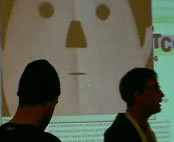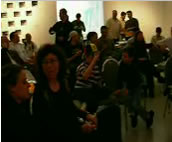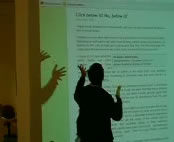In “The Aesthetics of Failure†Kim Cascone writes about emerging glitch-based music.
…it is from the ‘failure’ of digital technology that this new work has emerged: glitches, bugs, application errors, system crashes, clipping aliasing, distortion, quantization noise, and even the noise floor of computer sound cards are the raw materials composers seek to incorporate into their music. (Cascone 13)

Exploring sounds present at the boundaries of digital-analog conversion foregrounds the materiality of sound in the era of digital reproduction; the background information (noise, technological aberrations) which is normally ignored becomes the subject of examination. While a focus on the technological construction of experience remains important, a focus on glitch aesthetics is responding to what is starting to seem like an outdated idea of digital media. The salient characteristic of the new media has less and less to do with data transcoding and “remix culture.†Instead of the properties of individual media files, their limits and potential for recombination, consider the emerging systems of data collection, data mining, predictive software analysis and technologies of control.
Images from Warm Not Cold at Net<3 show, CFA Gallery, Buffalo, NY
What are the significant differences between using iTunes and a CD player? Certainly with iTunes you can have thousands of songs available to you instantly, and you can search and sort and create playlists. Automation, convenience and flexibility are indeed differences but, I would say, do not represent a conceptually huge difference. The important difference is that iTunes captures and stores usage information. It is not just a machine for decoding files and turning them into speaker cone vibrations: you listen to it, and it listens to you too. Apple’s website describes the ability to use iTunes to create playlists based on such criteria as songs that you’ve played more than a certain number of times in the past month and reports that “…iTunes may be more obsessive about your collection than you are.†(Apple)

Through capturing usage as data, behavior becomes instrumentalized. Behavior becomes marked in data, minable and the subject of predictive algorithms. Of course, this data-capturing functionality is built into a whole range of technology, and on a case-by-case basis it’s not always clear whether it serves a surveillance purpose or a marketing purpose or a helpful customization purpose.
A musical response to this modality of digital media would have less to do with the foregrounding and aestheticization of non-musical sounds present at the boundaries of digital-analog conversion but rather with issues of usage data, predictive models and behavioral feedback. So where can we start listening for the glitches at the boundaries of control?

For starters, there is the popular arcade game Dance Dance Revolution. To succeed at the game, the player must read directions from a screen and hit corresponding pads with his feet in time to the beat of the music. Advanced players attain a mastery of complex steps in the higher game levels or opt to stay at lower levels and develop a “freestyle†performative approach. In either case the user in som way surrenders his himself to a programmatic music-based control structure.
 Next to that, consider the Sonic City project, a collaboration between Future Applications Lab and PLAY Studio, which uses custom software and wearable sensing devices to create an interactive musical instrument which relies on the user’s mobility and environmental conditions for input. The user wears headphones and an array of sensors (a microphone, proximity detectors, motion detector, a light sensor) all connected to a laptop in her backpack. The input from these sensors is interpreted by the software on the machine to generate music using predefined algorithms.
Next to that, consider the Sonic City project, a collaboration between Future Applications Lab and PLAY Studio, which uses custom software and wearable sensing devices to create an interactive musical instrument which relies on the user’s mobility and environmental conditions for input. The user wears headphones and an array of sensors (a microphone, proximity detectors, motion detector, a light sensor) all connected to a laptop in her backpack. The input from these sensors is interpreted by the software on the machine to generate music using predefined algorithms.
In the Sonic City documentation video, the user, though she is free to move as she wishes, finds herself modifying her movements in order to control the music. As the woman in the documentation gets closer to a busy street she says, “It gets better here…” One wonders if, under the spell of controlling the music/being controlled by the music, she would could actually walk right into traffic. (Sonic City)
Issues of surrender and control go to the center of our emotional involvement in art. But as the seductions proffered by the new media become automated based on real-time feedback and data analysis of past behavior, the terms of our surrender threaten to disappear into the background. At what point does seduction become manipulation? How do we start turning up the volume on the noise floor of social control?

“Apple – iTunes – Create Playlists†Apple. Apple Computer, Inc. 13 Apr. 2006 http://www.apple.com/itunes/playlists/
Cascone, Kim. “The Aesthetics of Failure: ‘Post-Digital’ Tendencies in Contemporary Computer Music.â€, Computer Music Journal 24.4 (2000): 13.
“Sonic City @ Future Applications Lab†Sonic City. The Viktoria Institute. 13 Apr. 2006 http://www.viktoria.se/fal/projects/soniccity/
